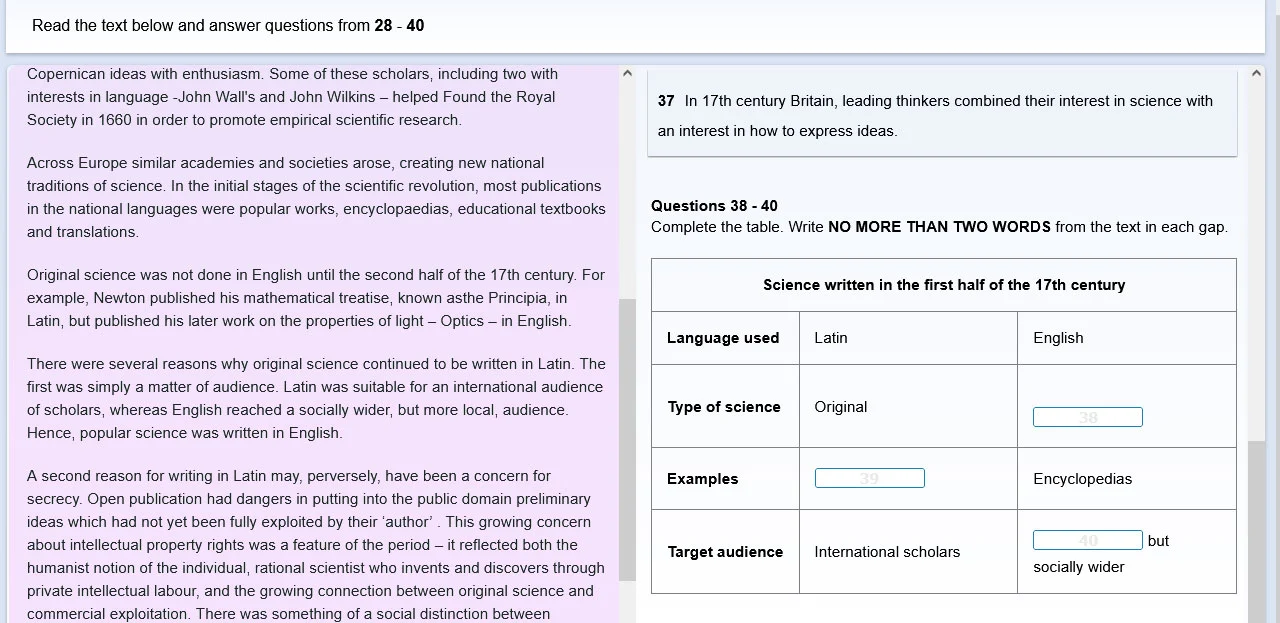IELTS Reading Tips | Table Completion Question
How to master the Table Completion Question
How to master the Table Completion Question
- A table is a way to categorise information described in a text. In IELTS Reading, the table completion question will involve filling in gaps using words taken directly from the text.
- The amount of information and its presentation in the table may seem overwhelming to some test-takers, but here are some tips and strategies that you can use to help you answer accurately, and use your time efficiently.

Useful Tips:
- You will need to fill in the gaps using words from the text. Read the instructions carefully as the will tell you how many words you may use for your answers. For instance, if the instructions say ‘use no more than 3 words’, you may use 1, 2 or 3 words from the text, but no more than that.
- Remember that the 20 minutes recommended are to be spent on the passage, but there will be more than one question type to use with it, not only the table completion one. If you have completed other question types relating to the passage prior to the table completion, this may help with understanding what the text is about, and complete the table more easily.
- Take the time to read all the information in the table. Ensure that you understand the titles in its columns, as well as the titles in its rows (if any). Pay attention to the information already provided in the table. Pick out and paraphrase key words/phrases that may be identified in the passage to help fill-in the gaps.
- Once you have identified the key words in the text, read carefully around them to make sure you understand the information and can choose the appropriate words as your answers.
- Looking at the sentences surrounding each gap, think of the grammar being used, and try to predict the type of word you will need to find the text. Will it be a verb or a noun? Perhaps a name? Remember, you must use words from the text as they appear in the text.
- In IELTS Reading, a good approach to skimming the text is reading the first and last paragraphs of the text to get a sense of its topic, as well as the first sentence of each paragraph, which normally serves as an introduction to the theme being covered.
- When you locate the information in the text, compare it with the information in the table, so that you can decide on the appropriate words to use as your answers. Always make time to double check your answers, including grammar and spelling.
- For time-management purposes, spend a maximum of 2 minutes skimming the passage.
- For this question type, answers tend to be found in a specific location in the passage. And tend to follow the order of the text. Use paraphrased key words to help find such location.
- What do word-limited answers mean in IELTS Reading question types? Fore example:
- Write NO MORE THAN THREE WORDS AND/OR A NUMBER
-
This means that you can use:
(1 word OR 2 words OR 3 words OR 1 number) OR (1 word + 1 number) OR (2 words + 1 number) OR (3 words + 1 number) - Words containing hyphens count as one word (e.g. ‘make-up’, ‘in-laws’, ‘low-level’, etc.)
- Even if a number is written out in letters, it counts as one number, regardless of how many words make up that number. For example, ‘three hundred and fifty’ are four words, but they count as one number (350). So ‘three hundred and fifty calories’ would be 1 number and 1 word.
- Contractions will not be used as answers (e.g. ‘aren’t’ instead of ‘are not’ or ‘don’t’ instead of ‘do not’).
- Now is the time to practise this type of question:
-
History of Country flagsCountries around the world choose colours for their flags that have a particular significance. The French flag is blue, white and red, and its original design dates back to 1794. The flag of Ireland is also of a tricolour nature, and is green, orange and white. It was formally confirmed in the year 1937.Moving to the African continent, the Tunisian flag as we know it today was adopted in 1827 and is red and white. The current flag of China, adopted in 1949, is red and yellow. On the South American side, the Colombian flag is yellow, blue and red and dates back to 1861.Write NO MORE THAN THREE WORDS from the passage in each gap.
France Ireland China Tunisia Colombia Colours Green, white, orange Red, yellow Yellow, blue, red Year current flag was officially recognised 1794 1827
Pay attention to the helpful notes below:
- Paraphrasing:
-
year current flag was officially recognised = year/date actual/today’s flag/design was adopted
countries = nationalities (French, Irish, Chinese, Tunisian, Colombian)
- We can see that the language to look out for will be nouns relating to colours and dates.
- Explanation:
- Below is the parts of the text where the answers are found:
-
'The French flag is blue, white and red'
- 'The flag of Ireland is also of a tricolour nature, and is green, orange and white. It was formally confirmed in the year 1937.'
- 'The current flag of China, adopted in 1949'
- 'the Tunisian flag as we know it today was adopted in 1827 and is red and white.'
- 'the Colombian flag is yellow, blue and red and dates back to 1861.'
1 comment

Nima BabazadehApr 07, 2024
1. blue white red2. red white3. 19374. red yellow5. 1861
You must login to post comments!